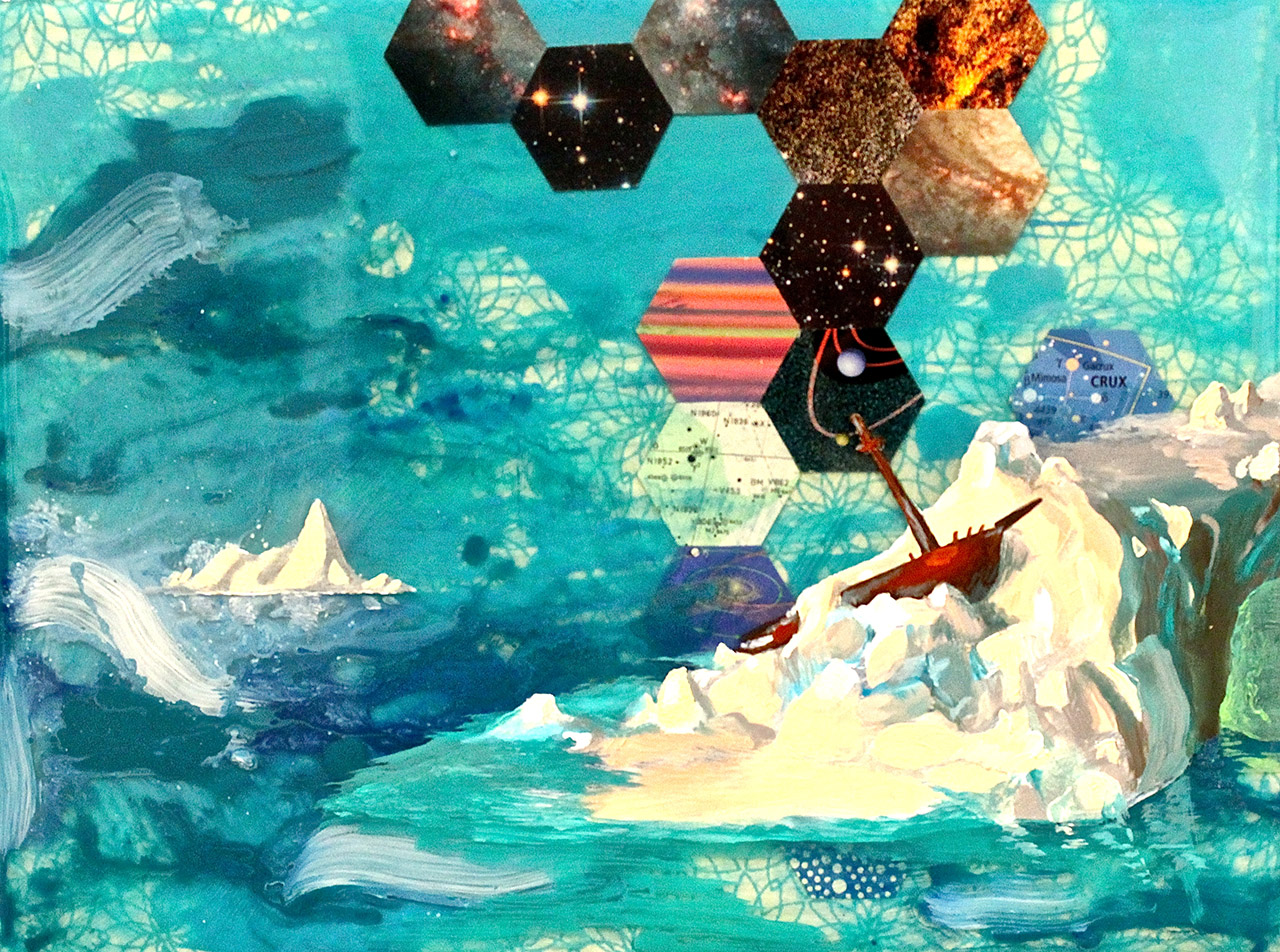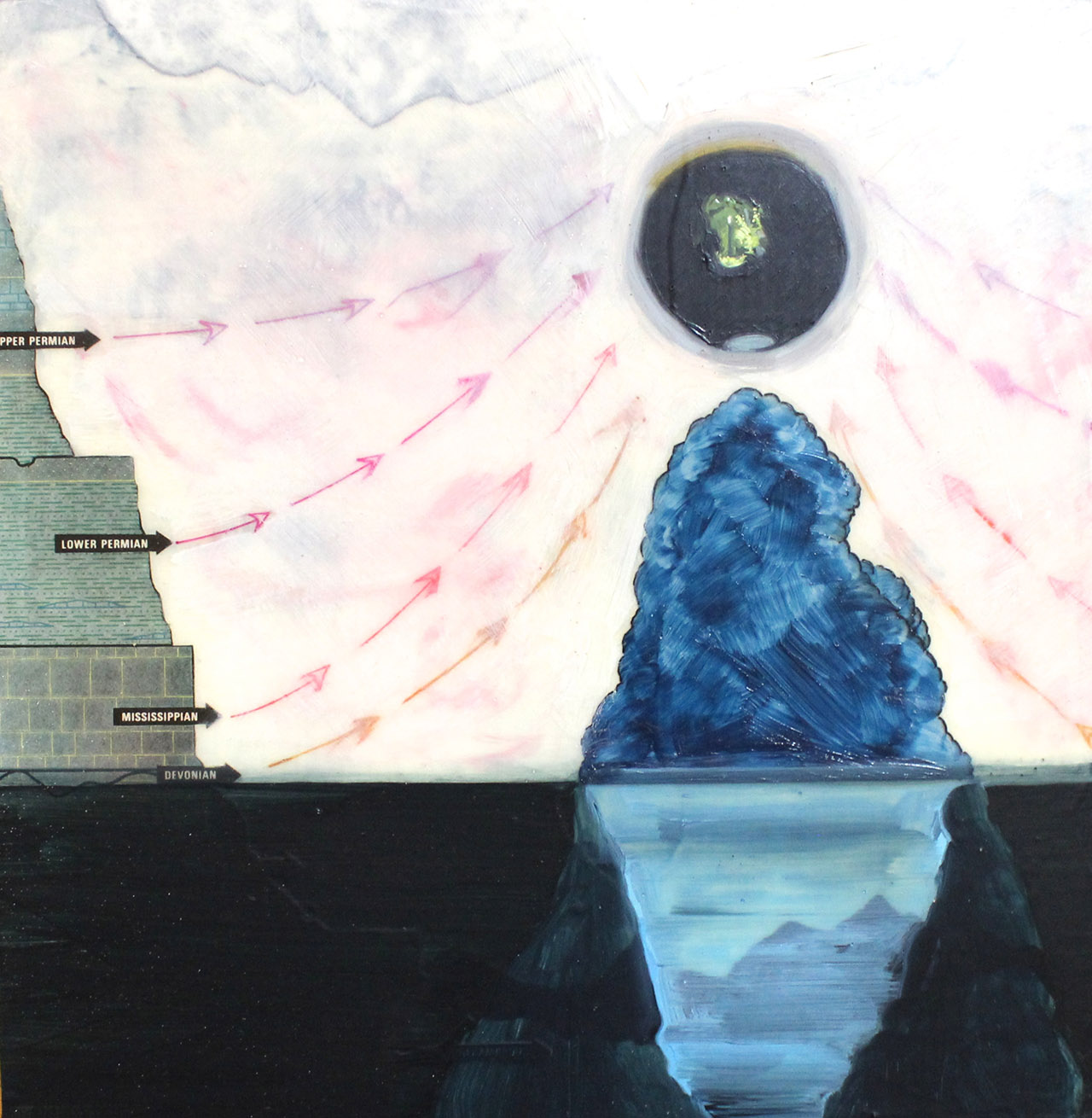
A two-person show at Popps Packing in Detroit creates a conceptual ‘Chimera’
Above: “Untitled” (2014) by Adrian Hatfield. Photos by Rosie Sharp.
The most thematically powerful aspect of “Chimera,” a two-person show featuring work by Adrian Hatfield and Amy Sacksteder, is not the way each artist amalgamates media or imagery, but the rather seamless and literal blending together of these two separate bodies of work, creating a chimera in and of itself. The show opened at Detroit’s Popps Packing gallery, a two-time Knight Arts grantee, on Jan. 23. As the title would suggest, it trades heavily on the blending of organic imagery into something imaginary or mythic.
The majority of Hatfield’s work aligns with the origins of the chimera, a creature from Greek mythology comprised of a fire-breathing lion’s head, a goat’s body and a serpent’s tail. But his spare and disturbing oil-on-linen paintings showcase subjects that are the melding of the back ends of animals–a kangaroo with the head of a lion’s hindquarters; the undercarriage of an octopus fused with the wing of a parrot; a lamb morphing into the hind legs of a rabbit. Adding to the alienating nature of these images, the creatures are pinioned or hung in abstract space–with at least one leg literally tethered or hanging from hooks, while the other set of legs sprawls or tries to run free. The backgrounds are vibrant fields of color, some with discernible imagery, like flowers or outer space, some that are abstracted ombre washes of peach, pink or red, with high-contrast black patches that give them landscape-like depth, even in abstraction.
This interplay between finely rendered subject and volatile background ties Hatfield’s work together strongly with Sacksteder’s. More than once, I found myself trying to decide, without the aid of gallery materials, which artist was responsible for a given piece (and in seeking clarity, found that I was mistaken). Among the works that are difficult to distinguish are Hatfield’s painted works with collage elements atop bright colors and flashes of painted details–a ship wrecked on icebergs, a tree standing alone in a snowy wildnerness, a pink high-heeled shoe falling from a cloudy sky. Some of these feature photo-collaged details cut into hexagon shapes–also incorporating images of outer space–built together into forms that mimic the scientific mapping of elements.

Works from the “Cairn” series by Amy Sacksteder.
Sacksteder also presents intricate collages, which create non-literal chimeras from materials, layering positive and negative cut-outs over washes of watercolor and detailed hand work. A watercolor naturescape seems to create an underground haven buried beneath a papercut rock surface. Many of her works fall under the series title, “Cairn,” referring to and ancient type of gravestone or marker, typically a pile of stones. While Hatfield’s renderings are more realistic, Sacksteder’s nonetheless tap a very vital sense of collective memory; there is an underlying motif of cellular forms in many of the works, suggesting a spiritual heritage that might be hardwired into our systems. To return to the show’s theme, Sacksteder’s work might be considered a visual chimera of magical realism and science fiction.
Together, these bold works really bounce off each other–there is no easy resting place for the eye anywhere. Similar palettes project colors from every surface. Hatfield’s creatures wrestle with themselves, struggle and pull at their bindings; Sacksteder’s scenes convey an “X-Files”-like sense of something unsettling sitting below the surface of unassuming situations, issues so fundamental that they might be rooted in our very biology, radiating discord on a mitochondrial level. The show’s final chimera is a collaborative work, appropriately titled “Chimera” (2015), which pairs Hatfield’s delicate renderings in oil with Sacksteder’s layered landscape-building and love of visual mirroring (for every positive projection that rises above the horizon line, there is a negative reciprocal that plunges below).

“Chimera” (2015) by Adrian Hatfield and Amy Sacksteder.
The references to alien landscapes and outer space gives everything a sense of cosmic perspective–perhaps we are all struggling to resolve these contradictions in our own nature, these threats to and from the systems that surround us. While contemporary American society encourages us to believe that more is better, that there is strength in multiplicity, this strong pairing of work by Hatfield and Sacksteder reminds us that our excesses can easily become (beautiful) monsters.
“Chimera” will be on display at Popps Packing through Feb. 13.
Recent Content
-
Artsarticle ·
-
Artsarticle ·
-
Artsarticle ·

